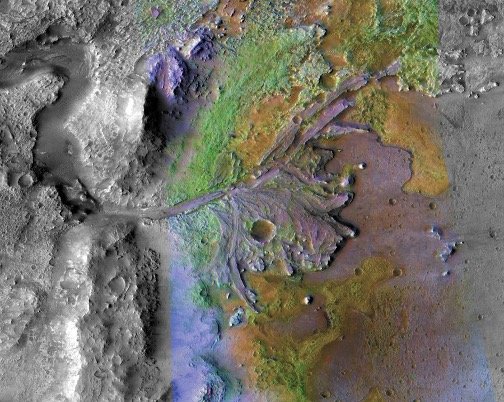

Welcome to this week’s installment of The Intelligence Brief. In this edition, all eyes are on Mars as NASA’s Perseverance rover successfully completed the final phase of its journey, after traveling nearly seven months and close to 300 million miles. We’ll be looking at 1) the rough ride that comprised Perseverance’s final seven minutes, 2) what the 2020 Mars rover hopes to find now that it has arrived, and 3) how scientists plan to get samples the rover acquires back to Earth.
In addition to our coverage here in The Intelligence Brief, over on our main site The Debrief team has featured a number of articles in advance of Perseverance’s arrival, which includes Chris Plain’s piece on the Mars helicopter Ingenuity, and why it’s first flight will be a “Wright Brothers Moment.” Looking back to past missions, Plain also asks whether we might have found life on Mars back in 1976 with the initial tests conducted by Viking 1. Lastly, in my article on humanity’s lasting fascination with Mars, we go even further back in time to antiquity, beginning with the Red Planet’s early associations with gods of war (among other things), before moving on to the development of the ideas over time about Martian life, and whether it might eventually be confirmed to have existed there.
Of course, we have plenty of non-Martian news as well–but still involving what could almost be aliens, or which might actually be aliens–which can be enjoyed as well. With all that out of the way, let’s dive into all things Martian.
The Final Stretch
It’s a big week for Mars, and for NASA, as the space agency’s Perseverance rover made its final decent toward the Jezero crater on Thursday afternoon, and successfully landed on Martian soil.
The rover, roughly the size of a small automobile, is the cornerstone of NASA’s Mars 2020 mission. After seven minutes of hurtling through the thin Martian atmosphere–moving more quickly than radio transmissions are capable of relaying its condition back to mission control at NASA’s Kennedy Space Center–the landing occurred as planned and according to schedule, without any significant issues.
Perseverance (or “Percy” as some of NASA’s engineering team have nicknamed it) was equipped with parachutes, as well as a jet pack that aided safe navigation toward its target landing area within Jezero crater. While similar methods succeeded in bringing the Curiosity rover down to Martian soil back in 2012, one can begin to see why NASA engineers refer to this final phase of the rover’s journey as the “seven minutes of terror.” Imagine, if you will, the anxiety-inducing sleigh ride through hell that comprises the final moments before attempting to land a $2.4 billion nuclear-powered robot on the surface of a planet millions of miles away… yeah, and you thought your job was stressful.
Ghosts of the Martian Past (and Past Landings)
It would be accurate to say that few robots that have attempted similar harrowing missions in the past have survived the feat in one piece; only about half of the spacecraft that humans have ever sent to Mars made successful landings. As noted in last week’s Intelligence Brief, the Martian landscape is littered with failed attempts at landings similar to what Perseverance managed to achieve today; the veritable “ghosts” of past missions to the Red Planet. Having safely landed, Percy’s adventures in the Jezero crater may lead to the discovery of other kinds of ghosts, too: possibly even the fossil remnants of ancient life that once existed there.
Among the primary goals of Perseverance’s mission is astrobiology studies and the search for evidence of organisms—past or present. Citing the search for ancient life forms on Mars one of its “key objectives,” NASA says that the Jezero Crater was chosen as the landing site for its 2020 mission on account of its aqueous past. Some 3.5 billion years ago, Jezero was once a lake which received water from nearby rivers that spilled over into its crater walls.
Today, astronomers can observe the distribution of minerals that indicate water once flowed into the crater, and during one of its many wet periods, the crater may even have been home to life forms that took refuge in the water it collected.


Another clue to Jezero’s possible past inhabitants has to do with the Martian clays that are found there today. “On Earth, scientists have found such clays in the Mississippi river delta,” NASA’s Mars 2020 web page says, “where microbial life has been found embedded in the rock itself.” It is possible, therefore, that past conditions on Mars during wetter periods might have also facilitated homes for its ancient microbes, if ever it had any.
Perseverance will search for evidence of such ancient life forms, the fossil remnants of which may still be found along the ancient shorelines or lakebed where sediments might have accumulated over time, or even in the rocks themselves, as scientists have observed here on Earth.
From Earth to Mars, and Back Again
Perseverance will also “characterize the planet’s geology and past climate, pave the way for human exploration of the Red Planet, and be the first mission to collect and cache Martian rock and regolith,” according to a statement on the Mars 2020 Mission website. In addition to the possible presence of remnants of ancient microbial life along the lakebed and shorelines, fossilized microbes could be found in the rock and soil samples Perseverance will collect.
Of course, the regolith the Mars rover will be collecting (that is, the mixture of dust and broken rock the rover will be sampling) has to be retrieved in order for it to be studied by scientists on Earth. “Subsequent missions, currently under consideration by NASA in cooperation with the European Space Agency, would send spacecraft to Mars to collect these cached samples from the surface and return them to Earth for in-depth analysis,” the space agency says at its website.
The team here at The Debrief provided live video coverage of the landing on our YouTube Channel, which featured commentary by myself, Tim McMillan, MJ Banias, podcaster Michael Mataluni, and our cadre of writers and contributors as Perseverance now rolls forward in the next step toward understanding Mars and its environment. This, of course, in advance of future manned missions that will eventually bring humans to the Red Planet.
That wraps up this special Mars Mission 2020 edition of The Intelligence Brief. As always, don’t forget to subscribe and get email updates from us here, or read past editions of The Intelligence Brief at our website. Also, if you have a tip or other information you’d like to send along directly to me, you can email me at micah [@] the debrief.org.
Want more from The Debrief? Below you’ll find additional breaking news and other stories we’re covering:


- Humanity’s Enduring Fascination With Mars
Our fascination with Mars has endured for centuries, and recent days have shown that we are closer than ever to unlocking the many mysteries of the Red Planet.
- Roboticist Behind Mars Helicopter Ingenuity Says First Flight Is “A Wright Brothers Moment”
The Debrief was given the chance to sit down with NASA’s Jaakko Karras, the roboticist who built the Mars Helicopter Ingenuity.
- Did We Find Life on Mars in 1976? NASA Wasn’t Convinced Back Then, But All Subsequent Missions Prove Mars Was Habitable Once
Since 1976, scientists have continuously found hints that Mars is habitable and even harboring forms of life deep under the planet’s surface.
- Rare Mineral Commonly Found On Mars Turns Up in Antarctic Ice
After boring more than a mile into Antarctic ice, scientists have discovered a mineral rare on Earth that is commonly found on Mars.
- The Future of Urban Farming [Fork Farms & Climate Change] | Recap EP #4
On this episode of the The Official Debrief Podcast, we are all about food!
- Scientists Find Strange Creatures Deep Under the Antarctic Ice
Researchers with the British Antarctic Survey (BAS) made an unexpected and shocking discovery, finding several strange and potentially unknown marine life species living deep beneath the Antarctic ice.
- No, China Did Not Build A Time Machine
Recently, a document surfaced stating that the Chinese were building a time machine. Alas, it was a hoax, but time travel happens all the time.
- What is the Boeing Starliner Mission and Will it Succeed this Time?
Boeing’s Starliner is a reusable capsule designed to be used to transport crew to the ISS. The first mission didn’t go as planned but with the help of Space Ex, the Starliner has a new lease on life!
- Major Breakthrough in Quantum Electronic Warfare Achieved by Army Research
U.S. Army Research Labs say they are on their way to developing quantum electronic warfare, rendering adversaries EW systems obsolete.
- Aliens May Pollute and That Will Help Us Find Them
A new study hypothesizes that one of the best ways to find evidence of possible alien technology on exoplanets is to look for their pollution.
- The Great Mars Invasion of 2021
An “invasion” of Mars is currently underway… we look at this, the difficulty many past nations have had getting to Mars, and the latest US Navy activities which have led to UFO sightings.
